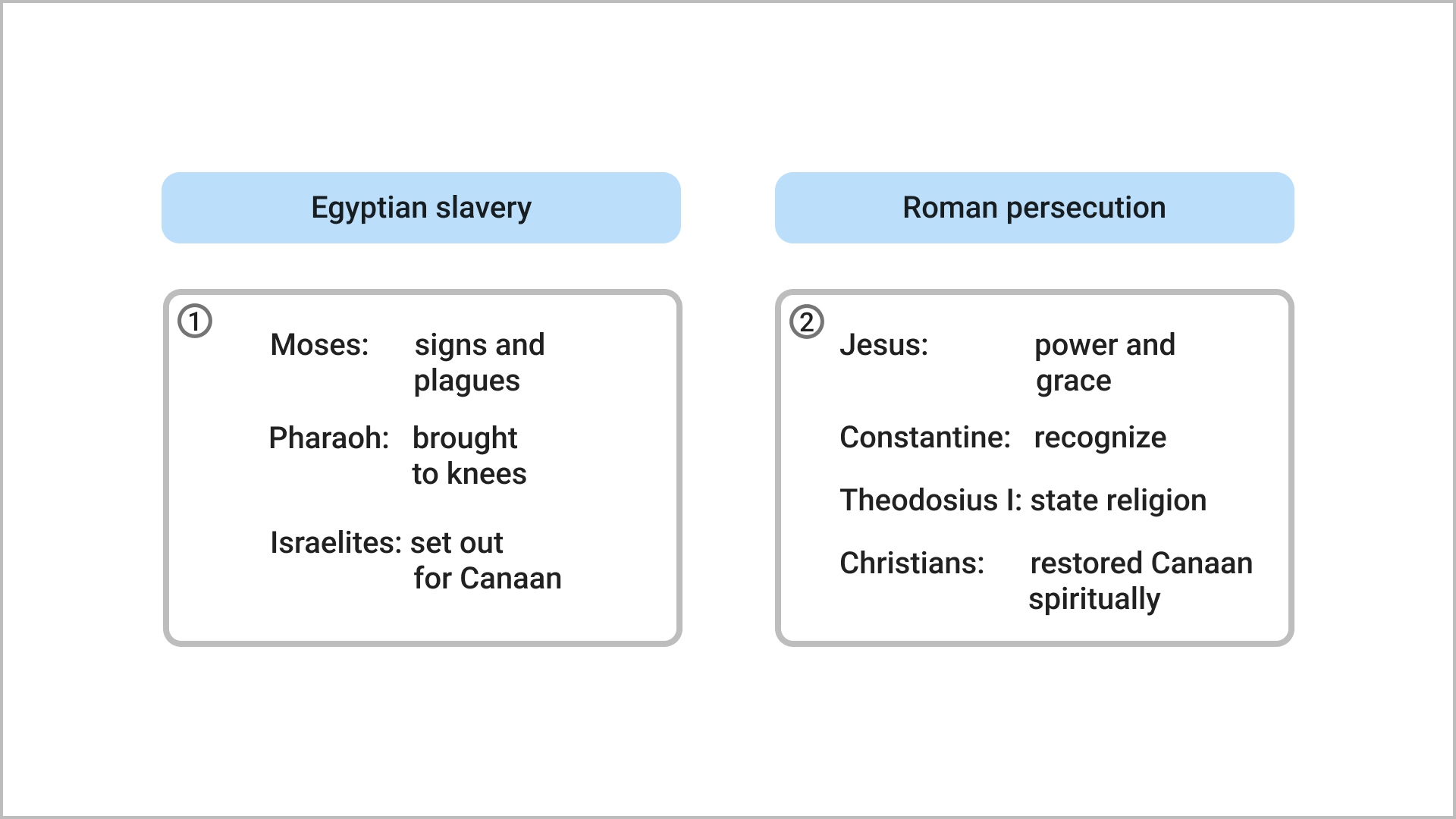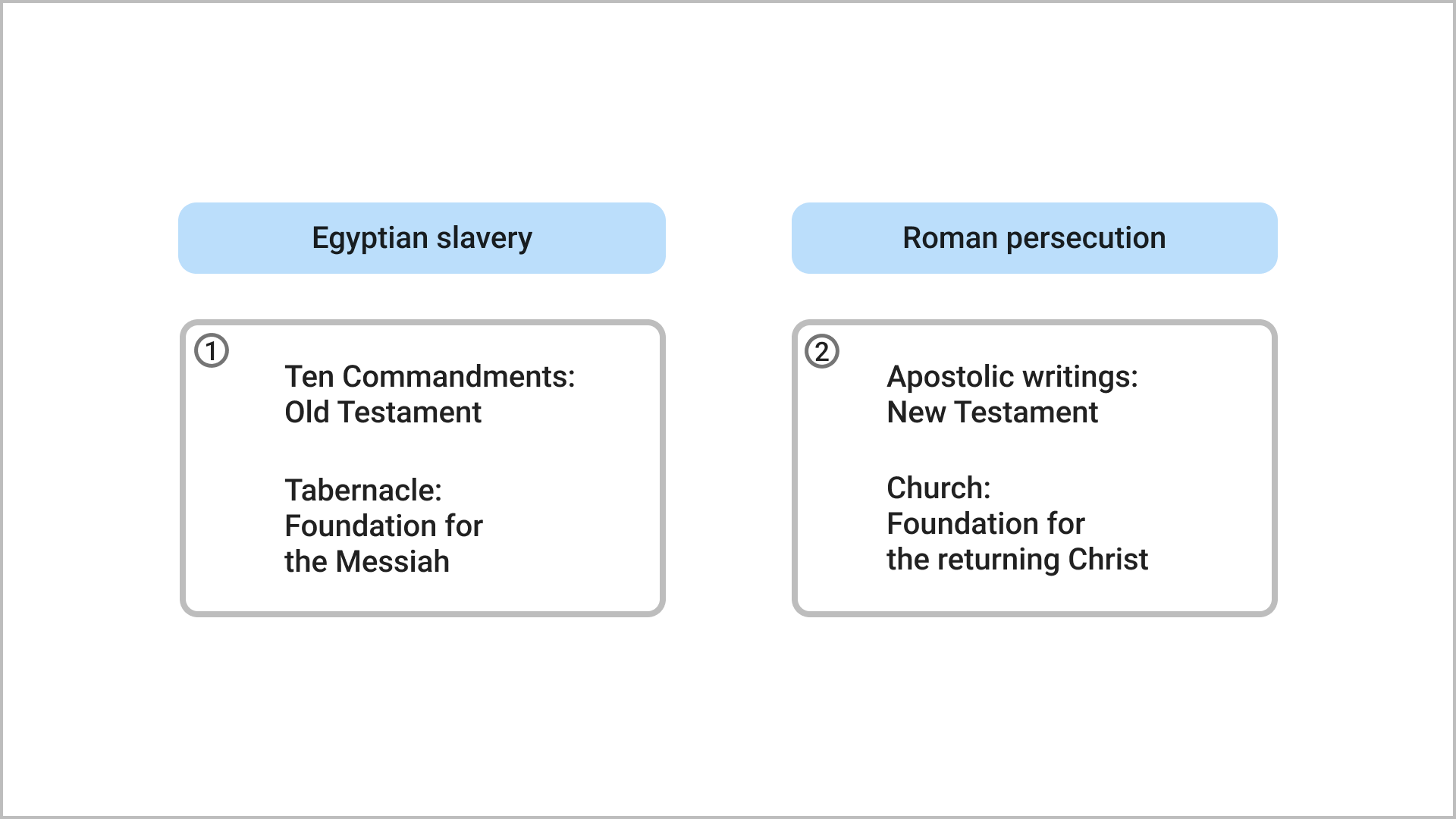Section 1. The Period of Slavery in Egypt and the Period of Persecution in the Roman Empire
노아로부터 아브라함까지의 400년 사탄 분립기간은 아브라함의 헌제 실수로 말미암아 사탄의 침범을 당하였으므로, 이 400년 기간을 다시 탕감복귀(蕩減復歸)하기 위한 애급고역시대(埃及苦役時代)에는 야곱과 그의 12자식을 중심한 70가족이 애급(埃及)으로 들어간 이래 그 후손들이 400년 동안 애급인들에게 처참한 학대를 받았었다. 이 시대를 실체적인 동시성으로 탕감복귀하는 로마제국 박해시대(迫害時代)에 있어서도 이스라엘 선민들이 예수님을 산 제물로 바치는 헌제(獻祭)에 실수하여 그를 십자가에 내줌으로써 사탄의 침범을 당하게 된 메시아 강림준비시대(降臨準備時代) 400년의 사탄 분립기간을 탕감복귀하기 위하여, 예수님을 중심한 12제자와 70문도 및 기독교신도들이 로마제국에서 400년 동안 처참한 박해를 당하지 않으면 아니 되었던 것이다.
After Jacob entered Egypt with his twelve sons and seventy kinsmen, their descendants suffered terrible abuse at the hands of the Egyptians for four hundred years. This was for the restoration of the four-hundred-year period from Noah to Abraham – a period for the separation of Satan – which had been defiled due to Abraham’s mistake in his offering. The corresponding period of persecution in the Roman Empire was to restore this previous period through parallel indemnity conditions. Jesus’ twelve apostles and seventy disciples were the first of many generations of Christians who suffered severe persecution in the Roman Empire over a period of four hundred years. By enduring this suffering, they were restoring through indemnity the four-hundred-year period of preparation for the advent of the Messiah – a period for the separation of Satan – which had been defiled due to the Jewish people’s mistake in not honoring Jesus as a living sacrifice but leading him to the cross.

애급고역시대(埃及苦役時代)에 있어서는 제1 이스라엘 선민들이 할례(割禮)를 하고(출 4 : 25), 희생(犧牲)을 드리며(출 5 : 3), 안식일(安息日)을 지키면서(출 16 : 23) 아브라함의 헌제 실수로 인하여 침범한 사탄을 분립하는 생활을 하였었다. 그러므로 로마제국 박해시대에도 제2 이스라엘 선민들이 성만찬(聖晩餐)과 세례(洗禮)를 베풀고, 성도 자신들을 생축(牲畜)의 제물로 드리며, 안식일을 지키는 것으로써 예수님을 십자가에 내줌으로 인하여 침범한 사탄을 분립하는 생활을 하지 않으면 아니 되었던 것이다.
In the period of slavery in Egypt, the chosen people of the First Israel kept themselves pure by circumcision, (Josh. 5:2-5) by making sacrifices (Exod. 5:3) and, as they left Egypt, by keeping the Sabbath (Exod. 16:23). During the period of persecution in the Roman Empire, the Christians as the Second Israel lived a life of purity by performing the sacraments of baptism and holy communion, offering themselves as sacrifices, and keeping the Sabbath. In both periods, they had to follow this way of pure faith to separate Satan, who was constantly assailing them due to the condition of previous mistakes by Abraham and the Jewish people.

애급고역시대에 있어서, 400년의 고역이 끝난 후에 모세는 3대 기적(三代奇蹟)과 10재앙(十災殃)의 권능으로 바로를 굴복시키고 제1 이스라엘 선민을 인도하여 애급을 떠나 가나안 땅으로 향하였다. 이와 같이 로마제국 박해시대에 있어서도, 제2 이스라엘 선민들에 대한 4세기 동안의 박해가 끝난 후에 예수님은 심령적인 기적과 권능으로써 많은 신도를 불러일으키셨고, 더 나아가 콘스탄티누스대제를 감화시켜서 313년에 기독교를 공인하게 하셨으며, 392년 테오도시우스 1세에 이르러서는 그처럼 극심한 박해를 하던 기독교를 국교(國敎)로 제정하게 하셨었다. 이리하여 기독교인들은 사탄세계에서 영적으로 가나안에 복귀하게 되었다.
At the end of Israel’s slavery in Egypt, Moses brought the Pharaoh to his knees by the power of the three signs and ten plagues. He then led the Israelites out of Egypt and set out for the land of Canaan. Likewise, toward the end of the period of persecution in the Roman Empire, after Christians had drunk the cup of persecution to the fill, Jesus increased the numbers of believers by moving their hearts with his power and grace. By stirring the heart of Emperor Constantine, Jesus led him to recognize Christianity in 313 A.D. Jesus inspired Theodosius I in 392 A.D. to establish Christianity as the state religion. Christians thus restored Canaan spiritually inside the Roman Empire, the satanic world.

그런데 율법(律法)에 의한 외적인 탕감조건(蕩減條件)으로써 섭리하시던 구약시대(舊約時代)에 있어서는 모세로 하여금 외적인 기사(奇事)와 권능으로써 바로를 굴복시키셨지만, 신약시대(新約時代)는 말씀에 의한 내적인 탕감조건으로 섭리하시는 시대이기 때문에 심령적인 감화로써 역사(役事)하셨다.
In the Old Testament Age, God worked through the external indemnity conditions set by the Mosaic Law; likewise, God had Moses defeat the Pharaoh through the external power of miracles. In the New Testament Age, when God worked through the internal indemnity conditions of faith, He manifested His power internally by moving the hearts of people.
애급고역시대(埃及苦役時代)가 끝난 후 모세는 시내산에서 십계명(十誡命)과 말씀을 받음으로써 구약성서의 중심을 세웠고, 석판(石板)과 성막(聖幕)과 법궤(法櫃)를 받듦으로써 제1 이스라엘 선민들이 메시아를 맞기 위한 뜻을 세워 나아가게 되었던 것이다. 이와 마찬가지로 제2 이스라엘 선민들은 로마제국 박해시대가 끝난 후에 구약시대의 십계명과 성막이상(聖幕理想)을 영적으로 이루기 위한 말씀으로서 사도(使徒)들의 기록을 모아 신약성서를 결정하고, 그 말씀을 중심한 교회를 이룩하여 가지고 재림주(再臨主)를 맞기 위한 터전을 넓혀 나오게 된 것이다. 예수님 이후에는 예수님과 성신(聖神)이 직접 성도들을 인도하셨기 때문에, 그 이전 섭리시대와 같이 어느 한 사람을 하늘 대신 전체적인 섭리의 중심인물(中心人物)로 세우지는 않으셨다.
When the period of slavery in Egypt was over, Moses on Mt. Sinai received the Ten Commandments and God’s Word revealed in the Law, which formed the core of the Old Testament Scriptures. By setting up and honoring the tablets of stone, the Ark of the Covenant and the Tabernacle, he paved the way for the Israelites to prepare for the coming of the Messiah. Likewise, at the conclusion of the period of persecution in the Roman Empire, Christians gathered the writings which had been left behind by the apostles and evangelists and established the canon of the New Testament. Based on these writings, they sought to realize God’s ideals spiritually, ideals which had been enshrined in the Ten Commandments and the Tabernacle in the Old Testament Age. They built up churches and expanded their foundation to prepare for the Second Coming of Christ. After Jesus’ ascension, the resurrected Jesus and the Holy Spirit guided Christians directly. Hence, God did not raise up any one person as the central figure responsible for His entire providence, as He had earlier.
